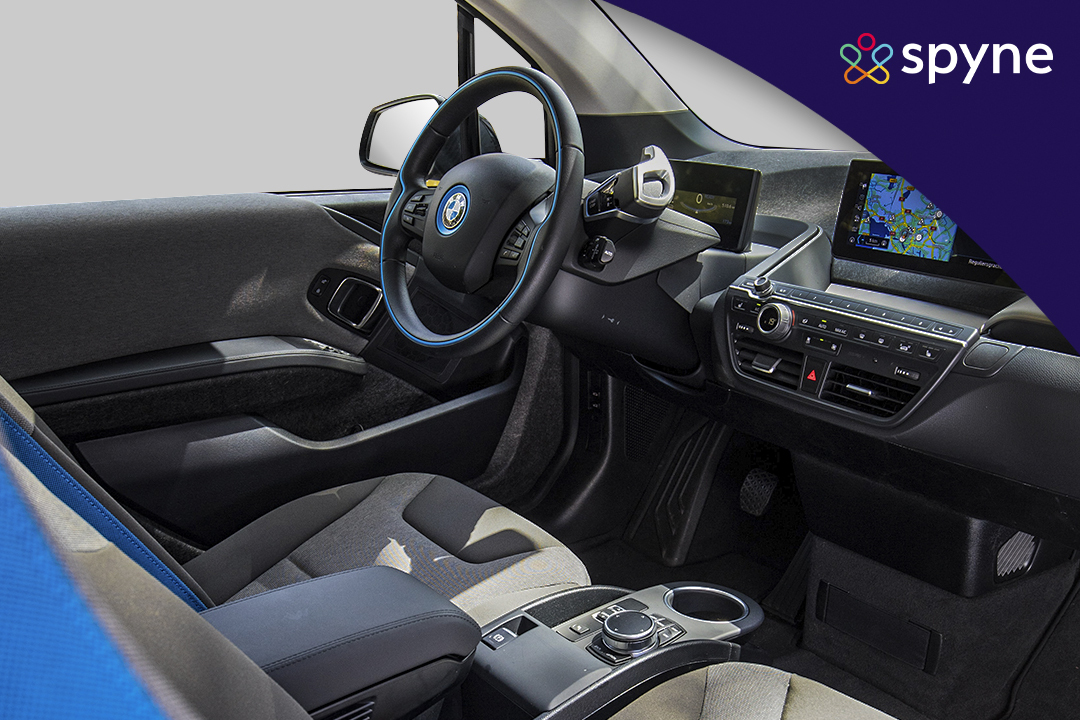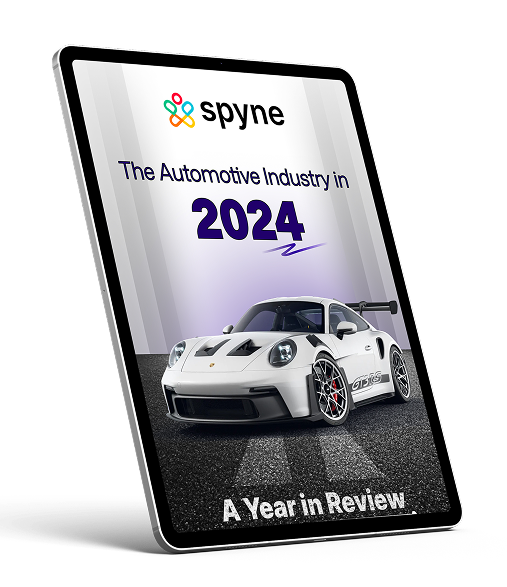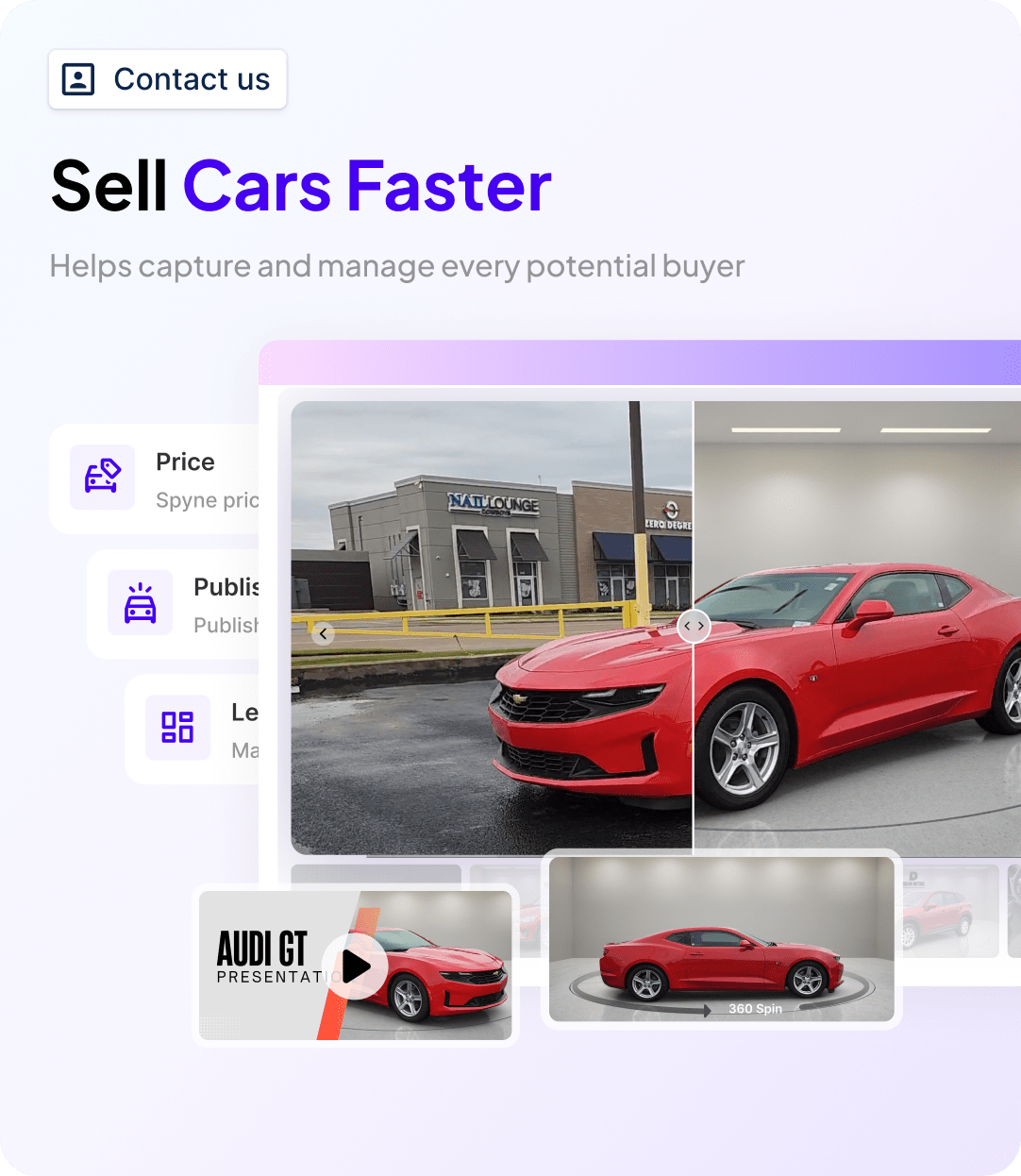75% of online customers depend on product photos when making purchases. This means good car interior photos play a major role in boosting sales. In fact, it is not just a choice but a necessity in today’s visually driven times.
Yet, photographers spend so much time shooting the exterior that they miss out on the interiors. But we must remember that buyers will spend 95% of their time inside the car. Thus, capturing the interiors well is non-negotiable.
So, that is what we will talk about in this blog. Read on to find out the complete A-Z of car interior pictures.
What is Car Interior Photography?
Capturing the intricate details of the inside of your vehicle – like the steering wheel, dashboard, center console, seats, etc. – is called car interior photography. Car owners spend most of their time inside the vehicle, so they need interior pictures to evaluate their purchase correctly. There are countless factors to consider when you shoot car interiors. There is lighting, color, reflections, and more. Since it is usually dark inside the car, it becomes trickier to click studio-like effects and take perfect shots.
Therefore, it becomes critical for all Car Photographers, dealers, and sellers to master the art of using flash, light, and lenses for the suitable car component at the right time. Here are a few aspects of car interior images to consider before you jump onto the bandwagon.
The Definitive Guide to Photographing Car Interiors Like a Pro
While capturing cars in the reel is enticing, car interiors are where the real beauty lies. But shooting this can be way different and more difficult than clicking exteriors. Unlike exteriors which are mostly smooth, interiors have more curves, textures, and lines. As a photographer, it is your duty to highlight them.
By looking at the style, comfort, and technology in a car, the customer gets a taste of the experience to expect. This is crucial as it is where they spend most of their time. However, getting sharp car interior shots doesn’t just require the right equipment and preparation but also technique. Here are some common mistakes and how to avoid them:
- Poor Lighting: Low lighting leads to underexposed and dull pictures. This doesn’t do justice to the interiors. So, you must try out different lighting options and find one that works best.
- Blurred Pictures: Camera shake or movement can lead to blurred images of interiors. Thus, you can use a tripod to keep the camera steady and get clear shots.
- Low Composition: Composition errors can destroy the entire image quality, deeming your images useless. To avoid this, you must take the time to figure out camera compositions. Try out different angles and positions to find a balanced one.
- Wrong Exposure: Over or underexposure of images is a common problem photographers go through. It changes the entire look of the car and doesn’t show the true elements. You can avoid this by changing the exposure setting and adding lights as required.
Why Do You Need Car Interior Images?
As mentioned above, a car buyer will spend more than half the time driving it. Now suppose there are two images of an SUV: one shot at night focusing only on the headlights and wheels, while the other one covers everything: starting from the body panels, headlights, rearview mirror, engine, seats, deck, and so on. Which one will you choose?
You know the answer.
Additionally, the close-up shots of the car not only give a clear view of the features but also validates the trademark capabilities of a branded vehicle. It becomes critical to give an idea of what the car looks like on the inside.
Research by MDG Advertising shows that good images can enhance the receptive skills of viewers by 65 percent. So, imagine what a good quality visual, including a detailed inside-car photo, can do to your sales. To guarantee results, auto dealerships frequently hire pros to handle their photography, but anyone can shoot these pictures if they know a few useful tips. This blog offers a few pointers to make vehicle interior photography easier in the realm of online shopping.
How do you photograph Car Interiors?
To help you understand car interior photography more easily, we will break it down into various segments. Let’s first understand how to click the perfect vehicle interior pictures.
How to take the perfect car interior shot?
The interior of a car is usually dark, either because of the closed or tinted windows. Helpful lighting or a mild flash can help eliminate that. Open windows and doors to let in more light. Likewise, change the camera’s settings accordingly. Because it’s darker inside, you typically require a slower shutter speed for car interior photos. There is little extra light for you to work with. Additionally, it’s unlikely that you can use a tripod, so you must learn how to stabilize your camera.
Moreover, backseat-equipped automobiles can simplify inside shots, while two-seaters may require complex camera placement to achieve the desired location. Roll the windows down or open the door and shoot through to get interior photos from the outside. Don’t be afraid to play around with your camera, to discover the best settings for Car Photography. Understanding your camera is the key, and knowing what ISO you can go up to in specific circumstances without getting too much chaos and grain is crucial.
Apart from this, detail shots are critical for the car inside pic. Note any specific attributes, such as the stitching on the seats. Car enthusiasts adore photos of attractive details.
How to leverage a one-light setup?
Soft lighting can do wonders when shooting still photos, like car interior images. Use this method to start your car interior photo session with a basic one-light setup. It works with almost any camera and lens (based on the lens, you’ll need to take your composition and subject distance into account).
You would need a simple softbox plus a Speedlight that can be activated off-camera. If you don’t have someone to help you hold the softbox while you capture, you’ll also require a light stand and perhaps a boom arm to place the light precisely.
Speaking of the basic setup, you may only need to put the light from the opposite side of the object. According to the vehicle, you can turn the wheel or take the roof off. Also, remember that you can unlock doors to position your camera precisely.
Additionally, you can alter your location and composition and try a few more photographs if the exposure appears to be good. No matter where you place the camera, the exposure will remain constant as long as the light doesn’t change.
Now, why does this work? A delicate and supple highlight is cast on all surfaces when it is pointed at by the softbox, which transforms the small Speedlight into a vast soft light. Bring the light close without intruding into the frame for the best results.
After shooting with light from above, try shooting with light coming from the side and behind, and then do it again while switching sides. You won’t need to adjust the exposure. Position the light such that it is roughly at eye level with the subject.
How to use light painting to shoot vehicle interior?
Light painting is generally used for shooting car exteriors. However, few people know that it can also add an edge to car interior photography.
Car interiors are simple to photograph with a single light source and a remote shutter. As is well known, a successful picture in commercial photography is the result of combining several images. One of the popular techniques is light painting using a continuous light source.
You can use a FE 24-105mm f/4 G OSS lens and operate your smartphone camera. You can also use an LED Light Stick for light painting. Then select the best photographs in editing software like Adobe Photoshop after capturing different such images.
You can test this technique with various continuous light sources, even with homemade light shapers, as it is both simple and exploratory. Good results are a sure thing with correct selection and combination.
Step-by-Step Guide to Car Interior Photography
Every car photography session has three phases, preparation, clicking shots, and post-processing. Let’s look at this entire process in steps for car interior pics:
Preparation for Car Interior Photos
- Choose a Car: When choosing a car, special attention should be paid to its interior design, features, and lighting. Spacious and well-lit cars are the best option here. Additionally, a panoramic sunroof, high-end sound, or other unique features further improve images.
- Clean it up: Neat insides make the images appear professional and visually appealing. Making people want to make a purchase. Thus, the carpets, seats, and dashboards of the car should be cleaned prior to photography.
- Find a suitable location: Even for car interior pics, location can make a huge difference. As that is what you see beyond the windows. In turn, the location should complement the car and not distract attention.
- Prepare Camera and Equipment: Setting up the camera and other gear is a crucial part. You must change camera settings, choose the right lenses, and check the tripod. For best results, one can also place the lights and take a few test shots.
Clicking Quality Car Interior Shots
Here is everything to keep in check when shooting car interiors:
- Composition: Composition can make or break your interior photos. Thus, you must take your sweet time to think about angles and placement. Using the rule of thirds also helps balance composition for best results.
- Lighting: Be it natural or artificial lights, doing it right is crucial. Good lighting can make a car’s insides look inviting and appealing by marrying the textures and colors. However, without it, interiors look dull and unappealing. And while there are many techniques, shooting during golden hours always helps. It adds a soft glow to the pictures, so they evoke a warm feeling. In the case of interior projects, you must use continuous lights in a controlled and even manner. The aim is to experiment and find the right lighting setup for every shot.
- Focus and Exposure: Changing focus and exposure can further improve clarity. You can use a small aperture and low ISO to achieve a shallow depth of field and draw attention. While different shutter speeds help find a balance between blur and sharpness.
- Camera Angles: Every car interior varies for another. Thus, shooting from different angles and heights is a must. For instance, shooting from above gives a bird’s eye view. In contrast, low-angle shots appear more spacious. Additionally, changing angles also highlights different interior designs.
- Getting the Details: Be it seat stitching, dashboard patterns, or door accents, they’re all worth capturing. The minor details can make a huge difference in attracting buyers. To get them, you must try out different frames, lighting, and settings for clarity.
Post Processing Essentials
- Filters: Car Photography presets are a quick and effective way to enhance images. At Spyne, you can find various options that enhance colors, style, and detail.
- Exposure and Colour: Adjusting exposure and color is the first post-processing step. It should be done to create a balance and improve picture quality.
- Cropping and Resizing: Cropping allows you to get the exact composition and ratio you want. However, be careful not to overdo it and save as many details as possible.
- Sharpening and Clarity: Sharp and clear images help the viewer get the exact idea of details and textures. However, overusing this can result in fake and processed images.
- Adding Final Enhances: These touchups must be performed to attract attention to the automobile. You can remove any distracting subjects, adjust brightness or contrast, and add a vignette if needed. They are little changes that can make a huge difference when done right.
What Items Will You Need to Shoot a Car Inside Images?
To shoot the perfect car-inside images, you will need three things:
A scrim
Scrim is a lightweight, strong fabric material placed between the light source to diffuse or reduce brightness. Its correct usage can do wonders for your car photography. When using a scrim, place the light source closer to the diffusion fabric to create a larger and softer light.
A lens polarizer
A lens polarizer will help you eliminate the reflections and shimmers caught by mirrors and glass. By using a polarizing filter, you can reduce distracting reflections on the bodywork and make the blues in the sky appear more intense. They are incredibly affordable and can assist in improving various images, so anyone interested in taking pictures of cars and landscapes should get one.
A light source
A camera flash and light bars are a must before you start shooting car interior images. Flashes help light up the gloomy interiors and highlight colors of different details. However, try to use a softer flash to get good lighting without any harsh shadows. Too powerful flashes will create white lines on the leather or plastic, refraining you from getting a smooth interior look.
What Features Do You Need to Highlight in Your Car Interior Photos?
Comfort and convenience are everything when it comes to car interiors. Focus on the must-have features to build priority over reliability, cost, or brand loyalty. Here are the top features that you should focus on when shooting your vehicle’s interior:
- Dashboard
- The instrument cluster and steering wheel
- Seats
- Cupholders and armrests (if available)
- Sunroof/moonroof
- Infotainment system
- Third-row seating (if available)
- Highlight features (heated/cooled seats, navigation system, rear-seat entertainment system)
Consider buying a 360-degree camera for car interior 360 photoshoots. A complete spin view of your vehicle’s inside will help shoppers experience it virtually.
Some Interior Design Ideas for Car-Inside Pictures
Your numerous filters and lighting will fail to create an impression if it’s not decked up perfectly, contains wear and tear everywhere, or isn’t good to look at. Here are some interior design ideas before you kick start the car interior photography.
Putting new car seat covers
Replacing the seat coverings in your automobile with new, fashionable ones is the simplest option. Numerous colors, species, and designs are available for these upholstery covers. Any cool design from sports teams, superheroes, or other variations might be incredibly effective.
Cover steering wheels with attractive fabric
Covering your steering wheel with a premium wrap – leather or fabric – is a great way to attract buyers toward the dashboard. Additionally, steering wheel covers come in a variety of styles that can enhance the vehicle’s aesthetic appeal.
Including all-weather floor mats
Floor mats are the next visible element in your car. In addition to serving as decoration, it shields the floor panel from dirt. You can choose from several textures, hues, and materials for floor mats to suit your preferences.
LED light strips
This specific idea for car décor will help you give a lounge-like atmosphere inside the vehicle. Present-day premium vehicles frequently have ambient lighting already installed. However, using the inexpensive but stylish LED lights on the dashboard and under the panel can add even more oomph to the aesthetics.
Infotainment screens
The majority of luxury car interiors come with infotainment screens already in place. Some vehicles (or their sub-variants) will have them; however, you may easily replace these OEM components with aftermarket ones that look better and have more functionality. You can choose from a variety of options for communication and entertainment, including large touchscreens, radios, navigation systems, etc.
Repair/install USB plug-ins
A USB plugin port is useful since it allows you to charge your gadget while you’re on the road at any time. These USB ports may power your smartphones or other devices or plug into the auxiliary input of the audio system.
Best Practices to Remember
When applied in commercial photography, car interior photos help highlight minute interior details, resulting in intriguing car photography composition. So, remember to choose a form or feature and think of a refreshing method to display it. Here are a few things to give a shot:
- Search for unique textures, patterns, or shapes. If you use covers for steering wheels or shiny floor mats, focus on them. Good car interior designs can give you a lot to choose from.
- To fill the frame, choose an object (such as an emblem or knob) and come up close. If you add too many interior details, your car’s inside pic could lose the distinct focal point.
- Try taking a landscape photograph from the windscreen or a pane, and play around with framing your image from the inside.
Tips and Tricks to Get the Best Car Interior Images
By now, you must have understood the nuances of car interior photography. To help you create top-notch car inside images, here are a few interior Car Photography Tips and tricks to follow.
The perfect location
Choosing a good location is critical even for interiors because you can still see what’s beyond the windows. Try to find a good location or shoot in a studio, to ensure that nothing distracting is visible. The optimal aperture for indoor photography is around F/4, allowing you to blur away any background coming in through the windows.
Cover as much as possible
Ensure you highlight every critical part of the vehicle, including the seats, tailgate, and everything else in between. For this, you can carry a list of necessary standard things and analyze if you require anything specific (it can be cup holders, a center console, or charging plug points).
Light up all the automotive interiors
Use a scrim and light bar for this. During the daytime, the sun can cast hot spots and areas of strong contrast, resulting in uneven lighting in your car interior photos. Making the dark areas soft using a scrim will help dilute some of the sun’s natural light.
Also, if you are shooting in the dark, you can use an Ice Light. You can either mount it on a stand or use it as a conventional light to focus the light where you want it to be. Trouble locations are typically foot wells, where heavy shadow lives, and windows that reflect the light. So be careful while capturing such elements.
Night-time shots for a car’s inside pics
LED accent lights are widely used in contemporary automobiles. Use them as much as possible to create a lovely effect. Of course, you need to experiment a lot to discover the best night Car Photography Camera Settings.
Here’s a cool idea: Try timing your exposure while running the engine at a high RPM with the tachometer whirling. Finally, take a picture of the windshield with a complete view from the back seat. Increase ambient lighting while keeping the illumination low.
Varying shots for interiors
Car interior photography need not be monotonous. Change your lens angle to capture various points, just like you would for the exterior. Shoot the steering wheel while seated in the back seat over the shoulder of the person in the front. Get closer to the subject, so the seat in front of you is blurry and adds dimension to the photograph. Alternately, crouch down right in front of the open door on the driver’s side and aim upward at the wheel. Your shot will appear more heroic.
Try the Spyne AI App for Interior Car Photography
Car interior photography is no rocket science! If techniques, effects, elements, and all these concepts feel overwhelming, you are in for a surprise. With the help of state-of-the-art, in-built, and zero-effort AI capabilities like Spyne, you can create studio-like high-impact car interior images.
- You maintain accurate light and brightness by following the on-screen guide.
- The overlay sketch helps you capture all relevant details from an accurate distance.
- You choose from over 100+ backgrounds for your car images.
- You can also apply customized backgrounds with one tap.
- Most importantly, you save time and editing costs through automated editing, processing hundreds of images at one go!
Not just interior, you can shoot high-quality car exterior pictures as well, along with a complete 360-degree spin view.
Does this intrigue you? Book a free demo today.
Final Word
Car interior photography may not land you as many likes or shares as a vehicle’s exterior shots, but it is critical for online sales conversions. When all relevant details are available on your online retail channels, shoppers can accurately evaluate the car virtually. With these tricks and tips, along with AI-led photography platforms like the Spyne AI app, you can create high-quality and lead-converting car inside images and win more hearts.
















